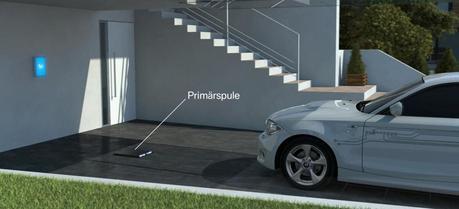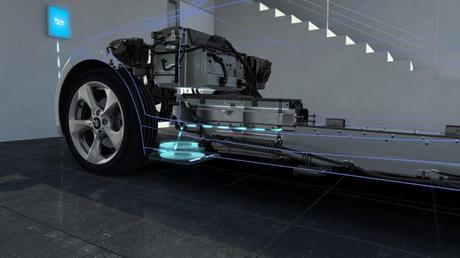 @Daimler and @BMW to develop standardized inductive charging for EVs. (Credit: BMW Group)
@Daimler and @BMW to develop standardized inductive charging for EVs. (Credit: BMW Group)In a recent press release by the BMW Group, the company outlines plans to develop and implement a standardized technology for inductive charging of electric cars and plug-in hybrids.
According to the same press-release, BMW has joined forces with Daimler on this project. So far, the companies have created an inductive charging system that consists of two components: a secondary coil in the vehicle floor and a base plate with a primary coil that is located underneath the car, for example on the garage floor. The electrical energy is transmitted via an alternating magnetic field generated between the coils, contact-free, without charging cables and at a charging rate of 3.6 kW. With an efficiency factor of over 90%, this method enables the high-voltage batteries in vehicles to be charged efficiently, conveniently and safely.
SEE ALSO: Researchers Create Better Transmitter Coils for Dynamic Wireless Charging

Architecture and structure of ‘inductive charging’. (Credit: BMW Group)
A further development target is to minimize the charging time for contactless power transmission. At a charging rate of 3.6 kilowatts, the high-voltage batteries in many plug-in hybrid vehicles can be fully charged in under three hours. It takes less than two hours to charge the BMW i8 using a fully working prototype of an inductive charging station. In order to make allowance for the higher storage capacities of high-voltage batteries in pure-electric vehicles, the future technology standard also foresees the possibility of increasing the charging rate to 7 kW. This ensures that the battery in the BMW i3 could still be fully charged overnight when using the inductive system.
Once the car has been correctly positioned above the primary coil, the driver can simply start the charging process at the push of a button using the vehicle’s own operating system. Data is transmitted via a WiFi connection between vehicle and charging station to help the driver even with parking.
According to the BMW Group, the inductive charging facility can be used regardless of the weather conditions—rain and snow have no negative effect on the power feed as all of the system’s conductive components are protected, which means the primary coil can be installed outdoors. During charging, ambient electromagnetic radiation is also kept to an absolute minimum. The space between the primary and secondary coils is permanently monitored, allowing charging to be halted instantly if any foreign bodies are detected.
As with today’s BMW i Wallbox, the inductive power supply systems of the future will also make it possible to activate and monitor the charging process from a smartphone. The relevant smartphone app will let drivers call up the data transmitted online on the battery’s charge status, for instance, or the time remaining until charging is complete.

